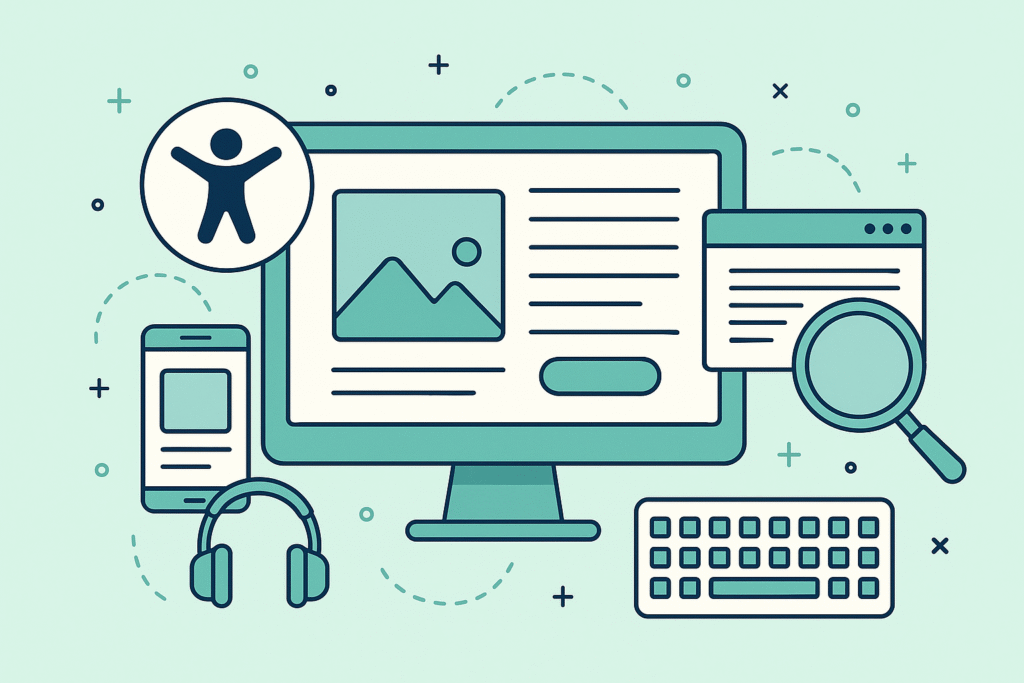Creating a website that’s accessible to all isn’t only about doing what’s right—it’s about building a digital space that reflects your values of inclusivity, care, and responsibility.
If you’ve heard of the Web Content Accessibility Guidelines (WCAG) but felt unsure where to begin, you’re not alone. WCAG 2.2 is the latest set of recommendations designed to help make websites more usable, welcoming, and supportive for everyone—including individuals with disabilities.
Here’s a compassionate and clear look at the WCAG 2.2 checklist every website should follow in 2025.
What Is WCAG 2.2?
WCAG 2.2 (Web Content Accessibility Guidelines) is an internationally recognized framework that helps make digital content more accessible. Created by the World Wide Web Consortium (W3C), these guidelines are built around four key principles:
- Perceivable
- Operable
- Understandable
- Robust
Together, these principles ensure your content can be accessed and used by as many people as possible—regardless of ability.
WCAG 2.2: Key Accessibility Checkpoints
Let’s walk through essential items from the WCAG 2.2 checklist that support inclusive and dependable website experiences:
- Focus Not Obscured (Minimum & Enhanced)
Ensure that when an element receives keyboard focus (like a form field or button), nothing blocks the view. This empowers keyboard users to navigate with clarity and confidence.
- Dragging Movements
If your website includes any drag-and-drop features, provide accessible alternatives—such as buttons or keyboard controls—so that everyone can interact with your content with ease.
- Target Size (Minimum)
All clickable elements should be comfortably sized (at least 24×24 CSS pixels) to prevent accidental clicks, especially for those with limited dexterity or who use assistive devices.
- Consistent Help
If you offer support like chatbots, FAQs, or phone lines, make sure they’re consistently placed across pages. This provides a reassuring and accessible experience, especially for visitors who rely on that assistance.
- Accessible Authentication
Make logging in more inclusive by removing cognitive challenges like solving puzzles or remembering passwords. Support alternatives like password managers or email-based access codes.
- Redundant Entry
Avoid requiring individuals to re-enter the same information more than once unless it’s necessary. This simple adjustment supports a smoother, more considerate user experience.
- Accessible Navigation
Provide clear headings, labels, and structure throughout your site. Consistent, predictable navigation empowers all visitors to move through your content with ease and confidence.
Why WCAG 2.2 Matters
Following WCAG 2.2 isn’t about checking off a list—it’s about extending care, support, and accessibility to everyone who visits your website. It’s a commitment to quality, empowerment, and community.
When you align your website with these standards, you’re creating something more than functional—you’re building something meaningful.
Moving Forward—With Guidance and Care
Accessibility is a journey, and we’re here to walk it with you. Whether you’re updating your current site or starting something new, aligning with WCAG 2.2 ensures that every visitor feels supported and welcomed.
Want help creating an inclusive, high-standard digital experience?
Moving forward with WCAG 2.2 means embracing a thoughtful approach to web accessibility—one that strengthens your connection with every visitor and fosters an inclusive digital community.
To support your journey, you can begin with our Accessibility Checklist, review our Accessibility Statement, or request a Free Website Audit to understand how your site measures up.
If you would like expert guidance with compassion and care, please reach out to us. We’re here to assist you reliably and respectfully every step of the way.


